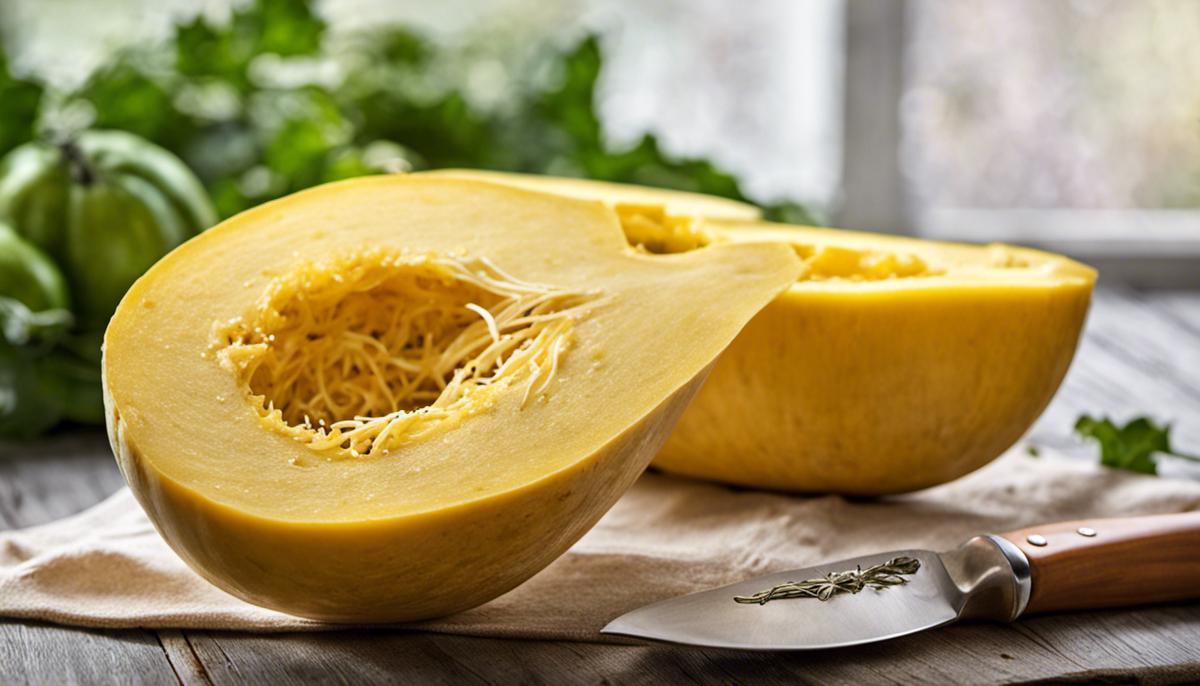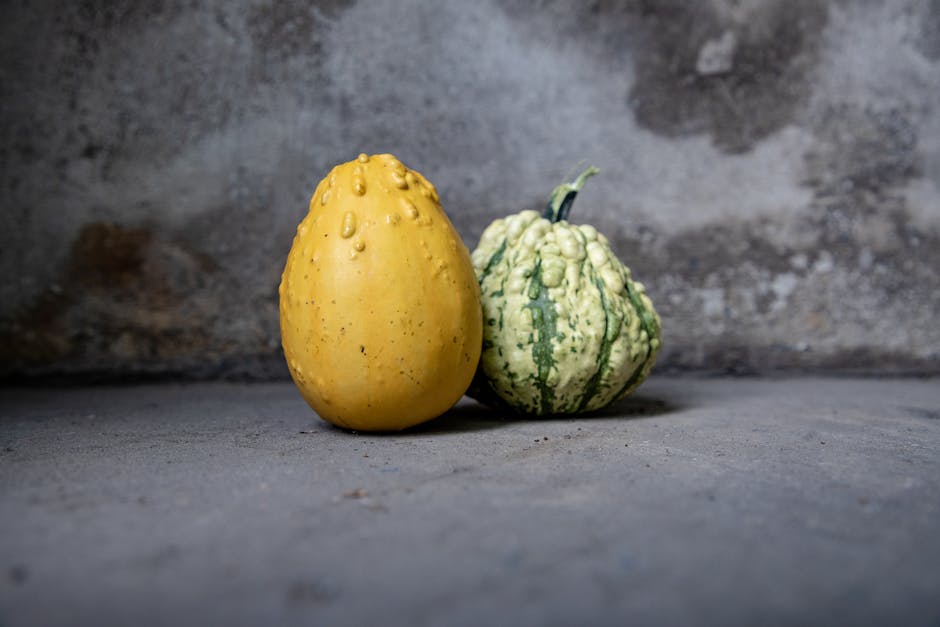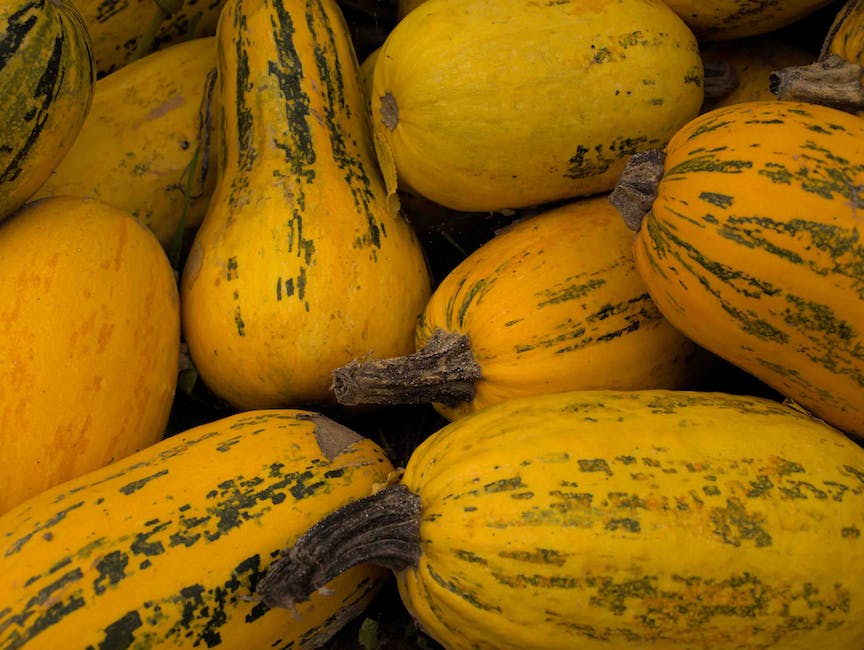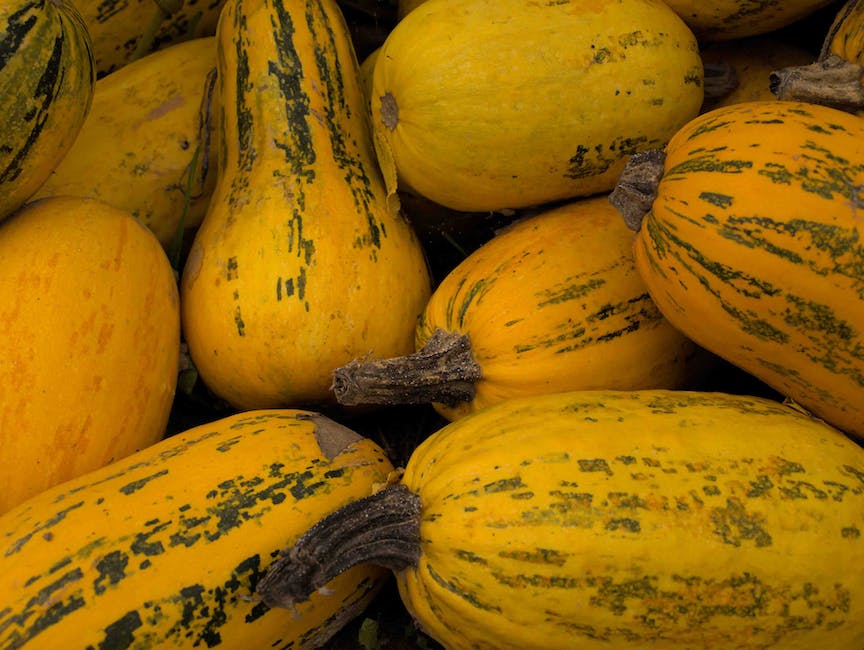Judging the Ripeness of Spaghetti Squash

When it comes to choosing the perfect spaghetti squash from the grocery store or our very own garden, assurance of its ripeness plays a crucial role. Picking it at just the right point of readiness ensures it lends the best texture and flavor to our meals. However, identifying a ripe spaghetti squash can be quite a task if you are unaware of the indications you need to look for. This article will discuss helpful tips and tricks to figure out if the spaghetti squash you’re considering is ripe and ready for consumption. The ripeness of spaghetti squash can be judged by examining its color, feeling its texture, and through the easy but effective fingernail test.
Recognizing the color of a ripe spaghetti squash
Color Cues: Spotting the Perfectly Ripe Spaghetti Squash
Food, with its myriad flavors, textures and aromas, serves as a universal tie that binds us all. One, however, may ponder on whether the joys of eating can compete with the thrill of joining the culinary hunt for the perfect ingredient. The answer to that can be found while hunting for a deceptively simple item – the spaghetti squash.
Garbed in an unlikely yellow, the spaghetti squash stands as the chameleon of the culinary world. Its name, artfully earned, does not signify a pasta variety. Instead, it references tender strands of a fully cooked squash mimicking spaghetti’s characteristics.
Sensing the perfect spaghetti squash begins by engaging the sense of sight. This elongated, watermelon-shaped vegetable asserts its ripeness through a uniform, golden yellow skin. The key word here is “golden”, veering more towards softer shades of yellow than bright, bold hues.
Moreover, the readiness of a spaghetti squash cannot be determined by any glistening sheen on the skin but instead by a mattified, dull appearance. The skin also becomes harder as the squash ripens, preserving the tender, flavorful flesh inside. Typically, this transformation happens with time, no longer green and unripe, but basking comfortably in its golden yellow skin, a sure sign of the fruit’s flavor having reached its zenith.
Just as in the immortal words of Elizabeth Gilbert, “Food is our common ground, a universal experience.”, the unassuming spaghetti squash has its delights to share. Rooted in its change of hue lies the heart of its flavor, waiting to be unleashed in one’s kitchen or savored in a cozy neighborhood bistro.
Discovering the right color of a ripe spaghetti squash is an essential lesson on this culinary journey. Embrace it and open doors to many more food explorations and conversations. After all, it’s through these shared experiences and knowledge that we deepen our connection to our food and to each other. Food is not only a necessity but an experience characterized by the thrill of the hunt, the joy of cooking, and the delight of the first bite. So, dive in, strap on the apron, and let your senses guide you in the kitchen – it’s time to cook up some magic with that perfectly ripe spaghetti squash!

Feeling the texture of spaghetti squash
The Feel of a Ripe Spaghetti Squash: A Crucial Ingredient to the Perfect Dish
There’s an inexplicable magic that unfolds within the kitchen when you engage all your senses in the culinary process. From seeing the vibrant colors of fresh produce, hearing the sizzle of a hot pan, smelling the aromatic herbs and spices, and tasting the final dish – every stage promises a gastronomical adventure. Beyond these four senses, touch is often overlooked. Yet, it is an enormously revealing aspect of the culinary journey. Feeling your way to determine the ripeness of fruits and vegetables can be the secret ingredient to creating a dish that ignites wide-eyed amazement at the table, especially when dealing with a unique vegetable like the spaghetti squash.
When selecting a spaghetti squash, the sense of touch matters just as much as the hue of the squash. A ripe spaghetti squash should feel firm to the touch, with a sturdy, hard skin that resists dents and scratches. Why, you wonder? Because knowing what a ripe and ready spaghetti squash feels like under your fingers is the final touch in ensuring that you have the best possible ingredient at your disposal.
Press gently yet firmly on the skin – it should resist your pressure without yielding or collapsing inward. This firmness signals the freshness and ripeness of the squash. If it yields to your pressure, it might already be past its prime and on the verge of going bad. An unripe squash, on the other hand, will have a softer rind and will fail to deliver the unique, pasta-like strands synonymous with a well-cooked spaghetti squash.
Furthermore, as you lift it, it should feel dense for its size. A spaghetti squash is similar to watermelon in this regard; it should feel heavier than it looks. That density signifies that the interior is full of succulent flesh, eagerly awaiting your culinary prowess.
Many gastronomes find a particular enjoyment in the act of tapping the skin. A ripe and ready-to-cook spaghetti squash produces a hollow, solid sound, much like a well-tuned drum. This auditory clue, which complements the tactile information, is another assurance of the fruit’s appropriate level of ripeness.
As you make your way through the food market or supermarket aisle, don’t rush the process of selecting the perfect spaghetti squash. Relish in the silent dialogue between you and the vegetable, tap it, lift it, understand its weight, and discern the hardness of its rind. It’s not just about buying a vegetable – it’s about embracing the joy of creating a remarkable, sensorial experience with food that begins long before the cooking process.
On your next kitchen endeavour, remember, it’s through these minute observations and intimate sensory encounters that we find our paths to a dish that doesn’t just satiate hunger but delights the senses and kindles conversation. And isn’t that what true culinary magnificence is all about? In essence, hold your spaghetti squash with confidence, understand its texture, and let it guide you, exploring a world of unique flavors and textures, and creating a connection that goes beyond the table. Your spaghetti squash is more than just a squash – it’s a shared memory in the making.

Testing the squash with the fingernail test
Turning now from sight to touch, one can apply the fingernail test to further determine the readiness of the spaghetti squash. This quick and easy test plays into the hands-on experience of selecting and preparing food that every culinary enthusiast devours with gusto.
The fingernail test is an age-old method used by countless food lovers around the globe. This test has been passed down from chef to chef, representing the experiential wisdom in the field of food exploration. The goal here is simple: to examine the resilience of the squash’s hard surface by gently pressing a fingernail into the skin. This tactile strategy embodies the joy of engaging with food, not merely as eaters, but as curious, sensory explorers.
When conducted correctly, the fingernail should not be able to penetrate the skin without some sturdy pressure. The resistance perceived is indicative of a ripe spaghetti squash, for a truly ripe squash is resilient, featuring a solid and firm exterior. This robust density signifies the rich, fibrous ‘spaghetti’ waiting inside, ready to bring warmth and joy to the dining table.
Yet, the sensory journey is not over, for alongside touch is the enchanting role of sound. When the squash is given a gentle tap, listen for a hollow sound. This sound is participatory dining, a melody that compliments the symphony of sensory exploration. It will tell a tale of ripeness, as a hollow sound resonates, indicating that the insides have developed perfectly into the spaghetti-like strands we’ve been waiting for.
Ultimately, the journey through the world of spaghetti squash is poignant with joy, filled with engaging sensory experiences and memories waiting to be created. The tactile communion with the squash, the dinner table chatter over shared plates, the texture, and the sound all tell a deeper, delicious story that goes beyond the actual eating—it’s about sharing, connecting and bonding over food. And that, after all, is what makes the culinary journey so spectacularly delightful.
Choosing a ripe spaghetti squash is not just an act, but a dance – a beautiful ballet between you and the squash, guided by the art of the senses. This dance will make your cooking experience unforgettable and will surely flavor every spaghetti squash meal with memorable conversations and shared experiences.
Enjoy the dance. After all, there’s so much more to cooking than meets the eye. It’s passion, discovery, and a little bit of magic—the joy of the journey before the delight of the first bite. Now, why not embrace this sensory experience and let the firm and ripe spaghetti squash lead the culinary waltz in your kitchen? After all, the best meals are those made not just with the right ingredients, but also with joy and a great sense of adventure. So, let the magic unfold, one touch, one sound at a time. Let your senses guide you in the kitchen, and allow the spaghetti squash to star in your home dining experience.

A thorough understanding of these determinants of ripeness – color, texture, and the fingernail test, can significantly help in taking the guesswork out of choosing a ripe spaghetti squash. It is an essential step to ensure you’re buying or picking a squash that is perfect for a sweet, aromatic and flavorful meal. So the next time you’re out to select a pinprick hard, golden-yellow spaghetti squash, keep these guidelines in mind. This knowledge not only makes your buying decision less complicated but also contributes to more satisfying culinary adventures. Happy Squashing!



